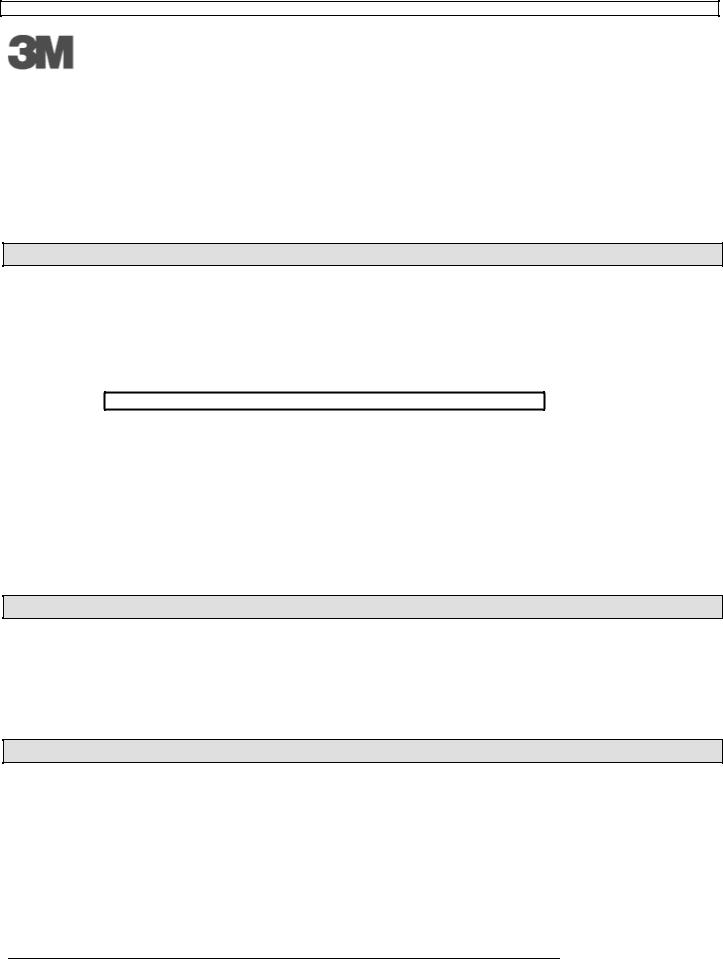3M HFE-7500 Data sheet

3M MATERIAL SAFETY DATA SHEET HFE-7500 3M ™NOVEC ™Engineered Fluid 07/19/2002
Material Safety Data Sheet
Copyright, 2002, Minnesota Mining and Manufacturing Company. All rights reserved. Copying and/or downloading of this information for the purpose of properly utilizing 3M products is allowed provided that: (1) the information is copied in full with no changes unless prior written agreement is obtained from 3M, and (2) neither the copy nor the original is resold or otherwise distributed with the intention of earning a profit thereon.
SECTION 1: PRODUCT AND COMPANY IDENTIFICATION
PRODUCT NAME: HFE-7500 3M ™NOVEC ™Engineered Fluid
MANUFACTURER: 3M
DIVISION: 3M Specialty Materials
ADDRESS: 3M Center
St. Paul, MN 55144-1000
EMERGENCY PHONE: 1-800-364-3577 or (651) 737-6501 (24 hours)
Issue Date: 07/19/2002
Supercedes Date: 07/19/2002
Document Group: 09-5959-3
Product Use: |
|
Intended Use: |
FOR INDUSTRIAL USE ONLY. NOT INTENDED FOR USE AS A MEDICAL |
|
DEVICE OR DRUG. |
Specific Use: |
HEAT TRANSFER |
SECTION 2: INGREDIENTS
Ingredient |
C.A.S. No. |
% by Wt |
3-ethoxy-1,1,1,2,3,4,4,5,5,6,6,6-dodecafluoro-2-trifluoromethyl-hexane |
297730-93-9 |
> 99 |
SECTION 3: HAZARDS IDENTIFICATION
3.1 EMERGENCY OVERVIEW
Specific Physical Form: liquid
Odor, Color, Grade: clear colorless, very faint sweet odor
General Physical Form: Liquid
Immediate health, physical, and environmental hazards: NONE KNOWN
3.2 POTENTIAL HEALTH EFFECTS
Page 1 of 7

3M MATERIAL SAFETY DATA SHEET HFE-7500 3M ™NOVEC ™Engineered Fluid 07/19/2002
Eye Contact:
Contact with the eyes during product use is not expected to result in significant irritation.
Skin Contact:
Contact with the skin during product use is not expected to result in significant irritation.
Inhalation:
If thermal decomposition occurs:
Respiratory Effects: Signs/symptoms may include cough, sneezing, shortness of breath, chest tightness, nasal discharge, and wheezing.
Ingestion:
No health effects are expected.
3.3POTENTIAL ENVIRONMENTAL EFFECTS
This substance has chemical moieties that are resistant to biodegradation and is likely to only undergo partial biodegradation in the environment. The high potential of this substance to move from water to the atmosphere means its potential to bioconcentrate is likely to disappear rapidly from aerobic environments.
AQUATIC TOXICITY: Testing results indicate that this product has insignificant toxicity to aquatic organisms at its saturation point (Lowest LC50, EC50, or IC50 > substance water solubility). This substance is highly volatile and has a high Henry's Law constant and is thus expected to move rapidly through vaporization from solution in an aquatic compartment or from a soil surface in a terrestrial compartment to the atmosphere.
ATMOSPHERIC FATE: Zero Oxone Depletion Potential (ODP).
Atmospheric Lifetime: ~2.2 years (based on reaction with OH radicals)
Global Warming Potential (GWP): 100 (100 year ITH)
SECTION 4: FIRST AID MEASURES
4.1 FIRST AID PROCEDURES
The following first aid recommendations are based on an assumption that appropriate personal and industrial hygiene practices are followed.
Eye Contact: Flush eyes with large amounts of water. Get medical attention.
Skin Contact: Wash affected area with soap and water. If signs/symptoms develop, get medical attention.
Inhalation: If signs/symptoms develop, remove person to fresh air. If signs/symptoms develop, get medical attention.
If Swallowed: Do not induce vomiting. Give victim two glasses of water. Never give anything by mouth to an unconscious person. If signs/symptoms develop, get medical attention.
SECTION 5: FIRE FIGHTING MEASURES
Page 2 of 7

3M MATERIAL SAFETY DATA SHEET HFE-7500 3M ™NOVEC ™Engineered Fluid 07/19/2002
5.1 FLAMMABLE PROPERTIES
Autoignition temperature |
332 ºC |
Flash Point |
Not Applicable |
Flammable Limits - LEL |
[Details: nonflammable] |
Flammable Limits - UEL |
[Details: nonflammable] |
5.2 EXTINGUISHING MEDIA
Material will not burn.
5.3 PROTECTION OF FIRE FIGHTERS
Special Fire Fighting Procedures: Water may be used to blanket the fire. Exposure to extreme heat can give rise to thermal decomposition. Wear full protective clothing, including helmet, self-contained, positive pressure or pressure demand breathing apparatus, bunker coat and pants, bands around arms, waist and legs, face mask, and protective covering for exposed areas of the head.
Unusual Fire and Explosion Hazards: No unusual fire or explosion hazards are anticipated. No unusual effects are anticipated during fire extinguishing operations. Avoid breathing the products and substances that may result from the thermal decomposition of the product or the other substances in the fire zone. Keep containers cool with water spray when exposed to fire to avoid rupture.
Note: See STABILITY AND REACTIVITY (SECTION 10) for hazardous combustion and thermal decomposition information.
SECTION 6: ACCIDENTAL RELEASE MEASURES
Accidental Release Measures: Observe precautions from other sections. Call 3MHELPS line (1-800-364-3577) for more information on handling and managing the spill. Evacuate unprotected and untrained personnel from hazard area. The spill should be cleaned up by qualified personnel. Ventilate the area with fresh air. Contain spill. Working from around the edges of the spill inward, cover with bentonite, vermiculite, or commercially available inorganic absorbent material. Mix in sufficient absorbent until it appears dry. Collect as much of the spilled material as possible. Clean up residue. Place in a metal container approved for transportation by appropriate authorities. Seal the container. Dispose of collected material as soon as possible.
In the event of a release of this material, the user should determine if the release qualifies as reportable according to local, state, and federal regulations.
SECTION 7: HANDLING AND STORAGE
7.1 HANDLING
Avoid skin contact with hot material. For industrial or professional use only. Contents may be under pressure, open carefully. No smoking: Smoking while using this product can result in contamination of the tobacco and/or smoke and lead to the formation of the hazardous decomposition products mentioned in the Reactivity Data section of this MSDS. Store work clothes separately from other clothing, food and tobacco products. Use general dilution ventilation and/or local exhaust ventilation to control airborne exposures to below Occupational Exposure Limits. If ventilation is not adequate, use respiratory protection equipment. Avoid continuous exposure of the material to extreme conditions of heat, i.e., above 150 C (welding, open flame, misuse or equipment failure). Avoid exceeding a watt density of 50 watts/inch2 from a heater surface. Continuous exposure to 150 C results in very slight decomposition of this product and therefore, is a very conservative use temperature threshold. Applications involving exposure of the fluid to temperatures exceeding 150 C or watt densities exceeding 50 watts/inch2 have been safely implemented. Applications which may exceed these use parameters should be reviewed with 3M Technical Service.
Page 3 of 7
